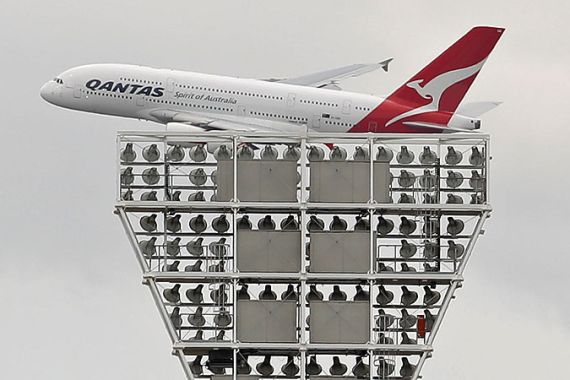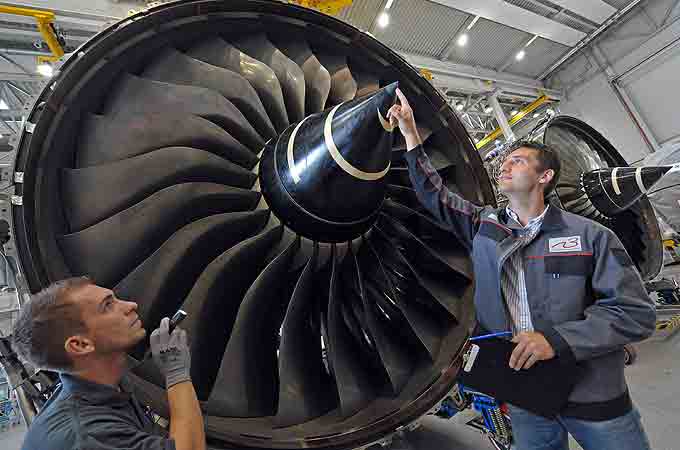Rolls Royce engine tests ordered
European air-safety authority issues directive following incident involving a Qantas Airbus A380 passenger jet.

 |
| Europe’s air safety regulator has directed airlines to run new tests for all Rolls Royce Trent 900 engines [EPA] |
Europe’s air safety regulator has ordered carriers to conduct new tests on Rolls Royce engines in A380 aircraft following a recent safety incident involving the world’s biggest passenger jet.
The European Aviation Safety Agency airlines using the Rolls Royce Trent 900 engines must conduct “repetitive inspections”, in its latest airworthiness directive posted on its website.
Keep reading
list of 4 itemsEurope pledges to boost aid to Sudan on unwelcome war anniversary
Birth, death, escape: Three women’s struggle through Sudan’s war
Mapping Israel-Lebanon cross-border attacks
The agency also said that an oil fire may have caused the failure of the engine disc on a Qantas flight nearly a week ago.
Following the directive, airlines will be required to carry out an extended “ground idle run” and inspections of parts of the engine.
Inspections will be required for “on-wing” engines initially within 10 flight cycles, where a flight cycle is typically one leg of an aircraft’s journey such as Sydney to Singapore.
The directive comes nearly a week after a mid-air blowout of a Trent 900 engine on the Qantas jet, forcing the Australian carrier to ground its entire Airbus fleet “until further notice” and re-organise its international flight schedule.
Qantas statement
Qantas said in a statement on Thursday that its new schedule would minimise delays which have affected thousands of passengers, and suggested it could be in place for weeks.
“The new forward schedule enables Qantas to accommodate customers on services across its entire international network over the coming weeks, regardless of when A380 aircraft re-enter service,” according to the statement.
“Qantas is continuing an intensive inspection programme on all Rolls Royce engines in its A380 fleet and Qantas engineers have removed three engines to undertake further examination.”
Qantas, which has not had a fatal air crash in almost 60 years, is among several airlines conducting urgent safety checks of Rolls Royce’s Trent 900 engines as investigators work to determine what caused last Thursday’s blow-out over the Indonesian island of Batam.
“We’re not really putting a time-frame on it at the moment. The situation’s really fluid,” a Qantas spokesman told AFP.
“It’s [the re-launch] unlikely to be within the next couple of days, beyond that we’re unwilling to say.”
Qantas said tests on engine performance under “operational conditions” will conform with the new European directive.
Precautionary step
In a related development, Singapore Airlines grounded three of its A380s on Wednesday to replace engines after finding unexpected oil stains during tests, while Germany’s Lufthansa said it would replace one A380 engine as a precaution.
The incidents have thrown the A380 – the aircraft vying with Boeing’s 787 Dreamliner in the long-haul sector – into the safety spotlight three years after it took to the skies.
“The incident has been detrimental to the image of the A380s and casts a shadow on the residual value of the aircraft,” Shukor Yusof, an aviation analyst with Standard and Poor’s in Singapore, said.
He also said it would affect UK-based Rolls Royce, which has so far only issued two statements since the incident involving the Qantas A380.
“This incident is not over yet until Rolls Royce is able to come out publicly to clarify the queries,” Shukor said.
There are 37 superjumbos in operation and airlines who have taken delivery are SIA, Qantas, Emirates, Lufthansa and Air France.
Boeing emergency
In other airline-industry news, Boeing, the US aircraft manufacturer, halted test flights of its new 787 Dreamliner initially scheduled for this week after an in-flight fire prompted an emergency landing.
Boeing said late on Wednesday the test fleet will remain grounded while investigations are conducted into an electrical fire on board one of the new jets.
A day earlier a 787 on a six-hour test flight was forced to make an emergency landing in Texas after the crew reported smoke in the rear of the aircraft.
Loretta Gunter, a Boeing spokeswoman, said the fire started in a power control panel in a rear electronics bay on the test aircraft, noting that it is unclear when the test flights will resume.